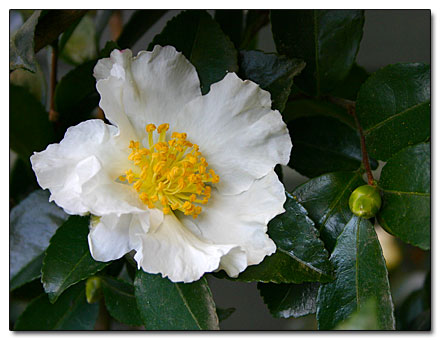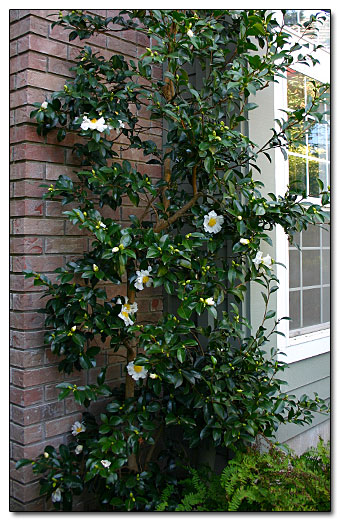Camellia sasanqua 'Setsugekka'
syn. 'Snow', 'Moon and Flowers', 'Fluted White', 'Wavy White', 'Elegant Friends'
Family: Theaceae
Pronounced: ka-MEEL-ee-a sa-SAN-kwa
Quick Jumps
Growing Guide
Rainy Side Notes
GROWING GUIDE

Origin:
Garden.
Plant Group:
Shrubs.
Hardiness:
Sunset zones: 4-9, 12, 14-24.
USDA zones: 7-8.
Heat zones: 8-7.
Mature size:
Height: 10-12 feet (3-4 m).
Width: 8-10 feet (2.5-3 m).
Flowering period:
October to January; some years it will flower until February.
Flowering attributes:
Large, semi-double, ruffled, white flowers.
Leaf attributes:
Shiny, evergreen, 1½ to 3½ inches long, dark green leaves.
Light:
Morning shade.
Soil:
Fertile, humus rich, moist, acidic, well-drained soil. Older, established plants are drought tolerant.
Feeding:
An acidic plant fertilizer is usually recommended; however, our soil in the maritime Pacific Northwest is normally acidic enough already. A soil test is recommended to determine if you need to adjust the ph level. Side-dress shrubs with compost and a complete organic fertilizer in spring and fertilize again in summer. If soil is not acidic enough, use a cottonseed for the nitrogen in your organic fertilizer mix. Do not over fertilize.
Propagation Methods:
Root leaf buds or semi-ripe cuttings from mid summer to late winter.
Pruning Methods:
This shrub needs little to no pruning; however, it takes well to pruning attention. In early spring take out dead wood; thin and/or remove crossing or rubbing branches. You can do radical pruning on these shrubs; however, it may take a few years before the bush will look good again and bloom.
Pests and Diseases:
No serious pests or diseases.
Rainy Side Notes

Camellia sasanqua 'Setsugekka' is one of the most popular cultivars of unknown parentage from the species sasanquas. The best reason for growing this shrub is for its fall to mid winter flowers, especially in eary winter--a time when little is in bloom. From October to January, it presents a spectacular bloom with semi-double, pure white, undulated petals with golden stamens. Unlike the C. japonica species and cultivars which hang on to its unsightly brown, mushy flowers that spoil its beauty, C. sasanqua's petals neatly fall from the shrub. This cultivar has an upright habit which can be espaliered, grown as a standard, or kept trimmed as an informal hedge.
In Lisa Albert's garden, she grows this camellia next to her entry way. "I planted my shrub where it is, not so much for the cultural environment, but because I thought it would look pretty espaliered against the brick column," she explains. It looks grand dressing up her entry way as well as providing a prominent view during winter when it flowers. Also sited there, her shrub is protected against prevailing winter winds and rains, while granting a shield from the frigid east winds the Portland, Oregon metropolitan area periodically experiences. In addition, its position provides shade during the morning hours when the sun would burn the flower's white petals.
It's important to plant camellias even with soil level. Be careful with mulch and compost; don't pile it up against the trunk.
Photographed in Lisa Albert's Tualitin, Oregon garden.
A Pacific Northwest Plant of the Week (2011)
Debbie Teashon

Gardening for the Homebrewer: Grow and Process Plants for Making Beer, Wine, Gruit, Cider, Perry, and More
By co-authors Debbie Teashon (Rainy Side Gardeners) and Wendy Tweton

